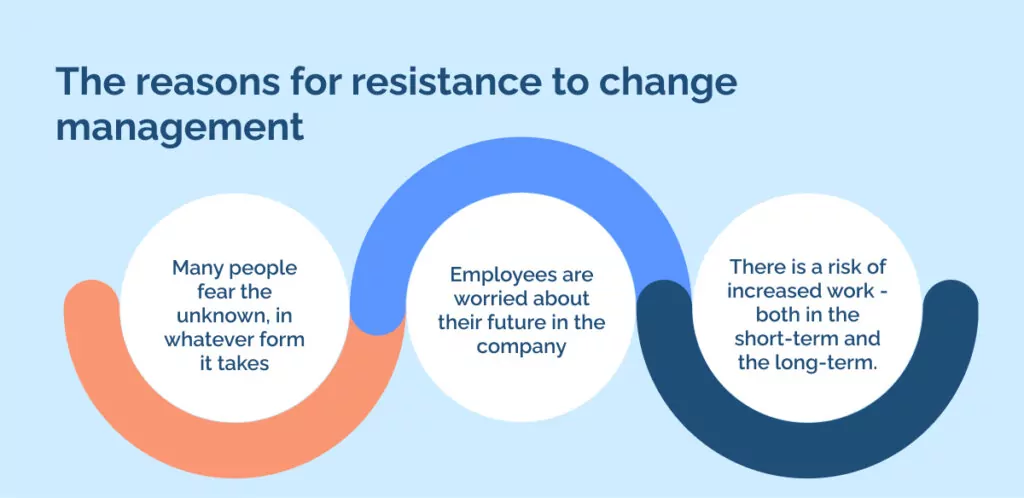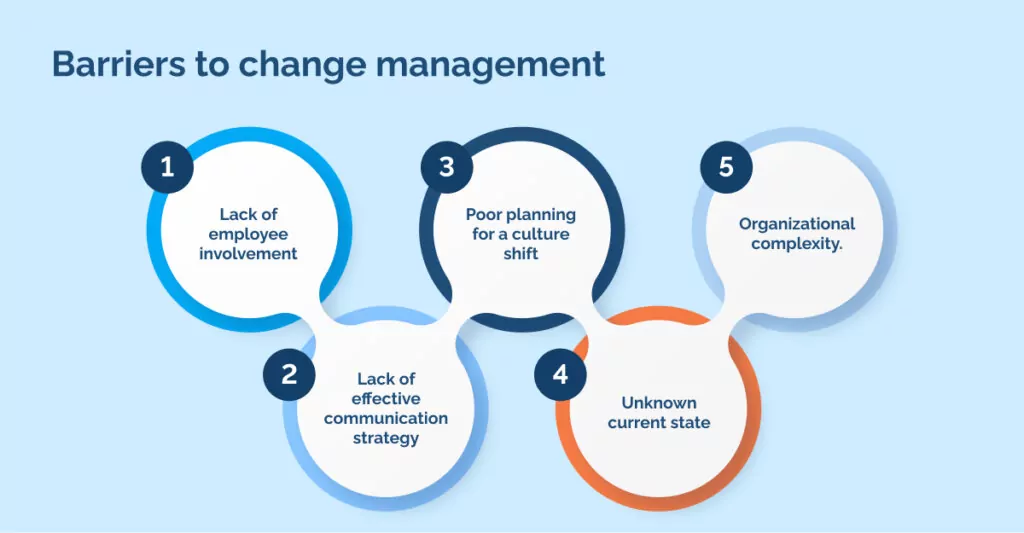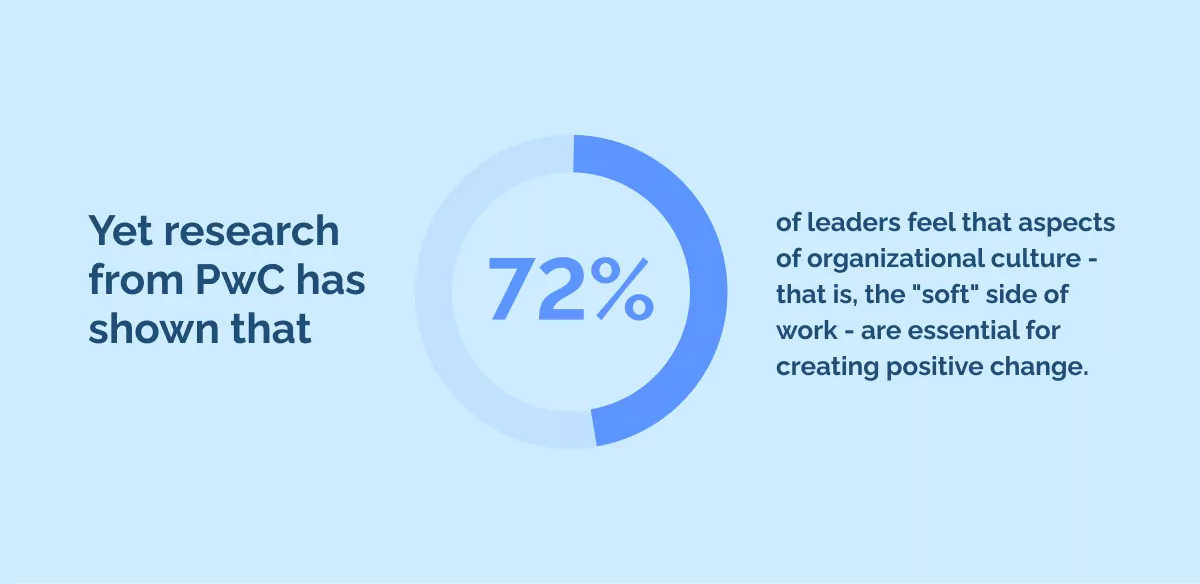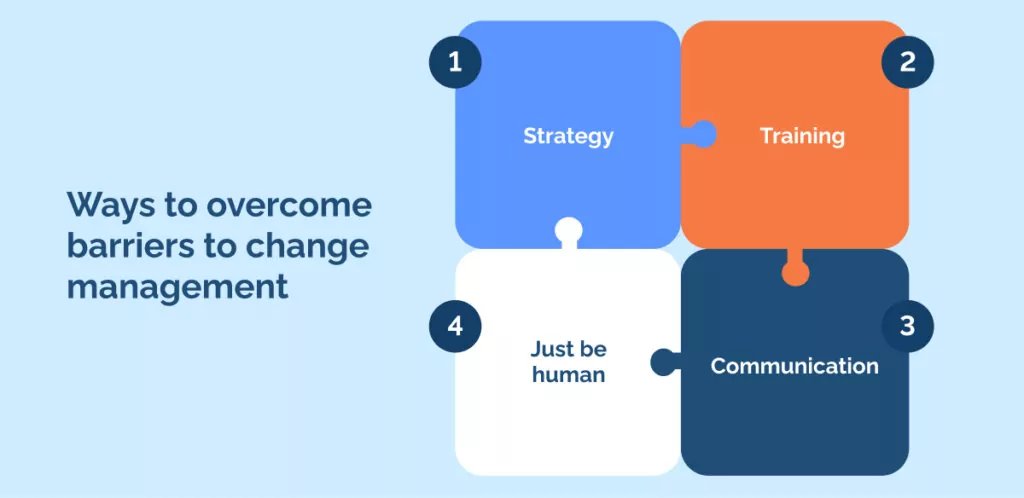
If you’re implementing any change project, the five top barriers to change you could encounter are:
- Lack of employee involvement
- Lack of effective communication strategy
- Poor planning for a culture shift
- Unknown current state
- Organizational complexity.
Sometimes, change comes quite naturally. Leaders start with a great vision. Staff are ready for a better way of working. And everyone comes together to move the organization from one state to another state.
However, most projects won’t be quite so easy. People will complain. The strategy will be bad. And the results won’t be as good as expected!
In our view, understanding barriers to successful change management is a great way to help implement change effectively. In this article, we’ll show you how to get ready for resistance to your change initiative. It will:
- Explain why companies introduce change in the first place
- Examine the causes for resistance to change projects
- Look at the five major barriers that face change projects
- Introduce four techniques for overcoming barriers in every organization.
There are no guarantees when it comes to change. But excellent preparation can often be the difference between success and failure.
Why change is necessary

Management teams don’t implement organizational change just for fun. Common types of change projects include things like creating a new management structure, revising business processes, or making staff redundant. These are expensive and risky procedures that might fail!
Change projects are worth it for the results they bring in challenging times. Some of the underlying reasons for change might include:
- An urgent need to improve efficiency and reduce costs
- Overcoming competitive disadvantages
- Incorporating innovation into the organization
- Responding to external factors (war, disease, economic downturn)
- Adapting to new customer needs
- Improving sustainability
- Improving a toxic and destructive workplace culture.
In these situations, leadership teams may find that major change is the only way to move to an improved state of affairs. Experience shows that organizational change can bring great results in the right situation.
You may like:
The reasons for resistance to change management

Even when change is necessary for the good of the organization and its staff, it is often subject to resistance from staff and existing structures. Why?
- Many people fear the unknown, in whatever form it takes
- Employees are worried about their future in the company
- There is a risk of increased work – both in the short-term and the long-term.
However, if your organization is struggling, these problems won’t be as important as the fight for survival. As such, employee resistance to change should not be a final barrier to change management.
In fact, it is important to understand that the barriers that make it difficult to implement change are usually the reasons behind the resistance to change.
But no matter how necessary the change is, it will be difficult for an organization to implement the planned strategic change successfully if barriers to change do exist. In this case, it is necessary to break all the barriers for successful planning and implementation of the change.
What are the barriers to change management?

Conducting a baseline assessment is an ideal process that will help any organization to identify potential and actual barriers to change. Barriers will always create a gap in recommended and current practices, eventually having a negative effect on the daily production process of the organization.
To prevent this from happening, it would be appropriate to pinpoint the major barriers to change as well as knowing how to stay clear of them. Once you know how to solve these barriers, it should be easy to plan and implement change. The most common barriers to change implementation are often the following.
1. Lack of employee involvement
This is perhaps the most common barrier to change management. Gartner’s research suggests that “more than 80% of organizations manage change from the top down“. This is not a workable solution.

The biggest mistake some organizations make is failure to involve employees in the change process. This spikes fear of the unknown, lack of desire to embrace a new culture, and eventually a complete barrier to the change.
Your efforts to introduce change can only succeed when you get employees involved in the change process as much as possible. This means listening to their opinion, accounting for their output, and assuring them that the change is for the good of all in the organization including them.
Providing relevant, sufficient resources to drive them towards change will be necessary too, so that they are comfortable and ready to adjust to the new development within the organization.
2. Lack of effective communication strategy
Some organizations have no effective communication strategy. In fact, some top leaders always assume that once they announce the change, people will adjust and be ready to get started with the new development.
CEOs should stop making announcements and instead introduce strategies. Employees do not need to know about the change only. They need to know how the change will affect them as well as how they will adapt to the change.
3. Poor planning for a culture shift
Sometimes the planning team has no idea how the change will affect people. Of course, the team at this stage will only concentrate on planning administrative structure, work area responsibilities, job responsibilities as well as the work reporting structure.

More often than not, the planning team doesn’t make enough decisions based on feelings and intuitions. This really overlooks how people feel, reason, and work hence the barrier to change. Yet research from PwC has shown that 72% of leaders feel that aspects of organizational culture – that is, the “soft” side of work – are essential for creating positive change.
The only way to break this barrier is for the planning team to understand that the organization must not overlook the feelings of the employees.
The organization has to do whatever it takes to prevent deep resentments, which usually occur due to disrespect of taboos and traditions at the workplace. Therefore, when focusing on critical thinking and objective analysis, it is important to understand that taking the feelings of the employees into account is quite a great way to overcome the barrier that usually hinders organizational changes.
4. Unknown current state
Change is always difficult for organizations that lack an idea of their current state. Trying to introduce and implement change without conducting an assessment and understanding the current blueprint of the organization is a common habit by many entities. It may cause a barrier to the change they hope to introduce and implement.
Once you take the time to go through the company blueprint and understand it clearly, it becomes easier to plan and transition to a future state.
5. Organization Complexity
There comes a time when organizations begin to develop complex processes, making the process of planning and implementing change a bit more difficult. The complexities include large processes, products, and systems, all of which contribute to change barriers because they are often quite hard for the members of the organization to understand.
It is necessary to break this barrier by introducing a keen and skillful approach to tackle organizational fast growth as well as complexity. An organization can break this barrier by employing a diligent, quality, and highly effective project and change management approach. It is wise, however, never to tackle a change that is going to be too complex for your organization.
You also do not want to introduce and try to implement complex changes if your organization still lacks the maturity to handle these kinds of large changes.
Ways to overcome barriers to change management

If you’re worried about barriers to your change management project. Don’t!
The management consultancy industry exists to help you get through change projects with a smile on your face. But before you rush off and spend all that cash, take a quick look at our review of the key areas to work on – strategy, training, communication, and plain old humanity:
Strategy
Get your change management strategy right from the beginning. There are many models out there – ADKAR, Lippit-Knoster, the McKinsey 7 Ss, to name just three. So there is no excuse for going into a change project without adequate preparation!
Training
Make training a cornerstone of your approach. You can explicitly use change management exercises to help employees to understand what lies ahead of them. And further down the line, a revised corporate training program will ensure that every staff member can maximize their talents.
Communication
Spend the time to prepare a plan for change management communication. Internal communication happens both formally and informally, and it’s up to the company’s change leaders to control the narrative as best they can. (By the way – when it comes to communication, remember that even technical changes can require a major workplace cultural transformation).
Just be human
Make sure you prepare for unpredictable human responses to change. The ProSci change management model, for example, is especially effective at dealing with the “human side” of organizational change. You can also train your leaders to deal with the most familiar responses to change projects. The Kubler-Ross change curve (first devised by Elizabeth Kubler-Ross) gives one template for reactions to the change process.
Planning for the success of your change initiative
Almost all change initiatives will ask employees to move on from their comfortable status quo. It’s no surprise when they fight back: but with good leadership, you can plan for the common barriers, and make good on your organizational priorities.
There is no certainty for any change initiative. But successful change management will often come from an in-depth understanding of employee needs – and excellent preparations to answer them.
WalkMe Team
WalkMe spearheaded the Digital Adoption Platform (DAP) for associations to use the maximum capacity of their advanced resources. Utilizing man-made consciousness, AI, and context-oriented direction, WalkMe adds a powerful UI layer to raise the computerized proficiency, everything being equal.



